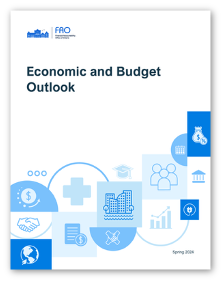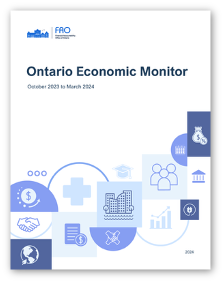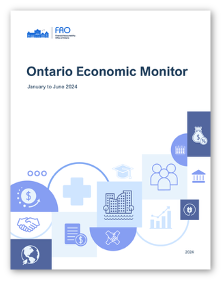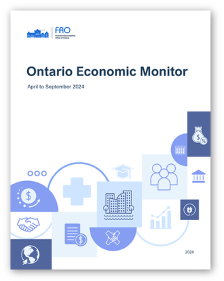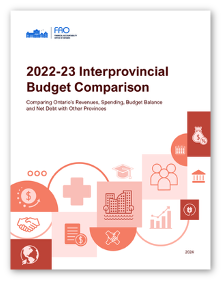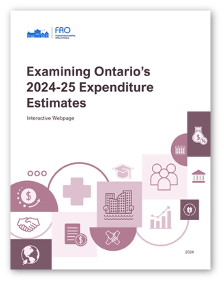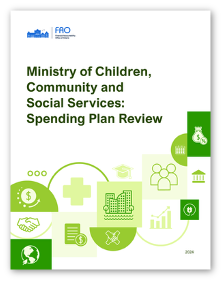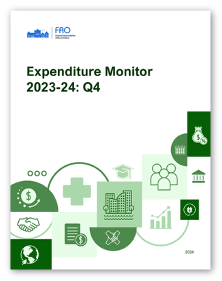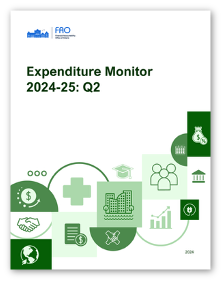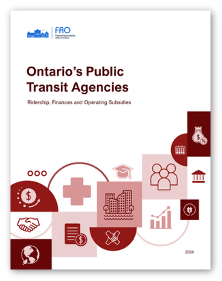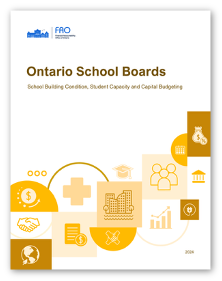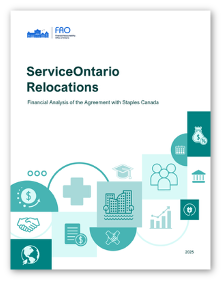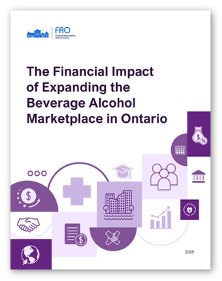
July 23, 2025
The Honourable Donna Skelly
Speaker of the Legislative Assembly of Ontario
Main Legislative Building, Room 180
Queen’s Park
Toronto, Ontario
M7A 1A2
Dear Madame Speaker:
In accordance with section 14 of the Financial Accountability Officer Act, 2013, I am pleased to present the 2024–25 Annual Report of the Financial Accountability Officer for your submission to the Legislative Assembly at the earliest reasonable opportunity.
Sincerely,
 Jeffrey Novak
Financial Accountability Officer
Jeffrey Novak
Financial Accountability Officer
Officer’s Note

This year marked the Financial Accountability Office of Ontario’s (FAO’s) 10-year anniversary. Established with a mandate to provide independent financial and economic analysis to MPPs and committees of the Legislative Assembly of Ontario, and with a dedicated team of 20 talented individuals, the FAO has become an important resource for all members of the Assembly. After 75 research requests from MPPs and committees, 162 FAO reports and over 1.4 million visits to our website, I am proud of the FAO’s achievements over its first decade and look forward to the years to come.
Over the last fiscal year, the FAO produced 14 reports, 14 briefing decks, nine videos and one interactive website tool. Four of our top five reports released in 2024-25, as measured by views on our website, were research requests initiated by MPPs: Ministry of Children, Community and Social Services: Spending Plan Review, The Financial Impact of Expanding the Beverage Alcohol Marketplace in Ontario, Ontario’s Public Transit Agencies: Ridership, Finances and Operating Subsidies, and Ontario School Boards: School Building Condition, Student Capacity and Capital Budgeting.
We introduced two new products in 2024-25. To better meet the FAO’s mandate to provide independent analysis about trends in the provincial economy, we launched a new quarterly report, the Ontario Economic Monitor. This report series reviews Ontario’s recent economic performance based on the latest economic indicators.
To support Standing Committees’ reviews of ministries’ Expenditure Estimates, the FAO created a new interactive webpage, Examining Ontario’s Expenditure Estimates. This webpage allows users to review a ministry’s Expenditure Estimates and compare requested spending against actual spending over the previous three years. Initially, the FAO completed analysis for seven ministries. However, the FAO added information on three more ministries at the request of MPPs.
Our office also implemented several service improvements in 2024-25 to better serve MPPs. To help keep MPPs informed about the FAO’s activities, we launched a revised quarterly newsletter that summarizes the FAO’s most recent completed work and lists upcoming FAO projects. To facilitate easier and quicker access to all of the FAO’s reports and other products, we refreshed our website. To better fit into MPPs’ busy schedules, we expanded the number of briefings offered to MPPs after the release of an FAO report. Finally, following the 2025 General Election, our office initiated an outreach campaign informing new and returning MPPs about the resources and services offered by the FAO.
Going forward, the FAO will continue to focus on its mission to provide MPPs and committees with independent, authoritative, accessible and timely financial and economic analysis. By building on the FAO’s accomplishments over its first decade, while always looking for opportunities to improve its services to members of the Assembly, I am confident that the FAO’s next decade will prove to be another success.
 Jeffrey Novak
Jeffrey Novak
Financial Accountability Officer
The FAO’s Mission and Mandate
Mission
To support the Legislative Assembly by providing members and committees with independent, authoritative, accessible and timely financial and economic analysis.
Mandate
The Financial Accountability Officer Act, 2013 sets out the mandate of the Financial Accountability Officer (the Officer). The Officer is required to provide independent analysis to the Assembly about the state of the Province’s finances, including the budget, and trends in the provincial and national economies.
In addition, the Officer may respond to requests from members and committees of the Assembly to undertake research into:
- the Province’s finances and trends in the provincial and national economies;
- the estimates and supplementary estimates submitted to the Legislature;
- the financial costs or financial benefits to the Province of any public bill that is before the Assembly; or
- to estimate the financial costs or financial benefits to the Province of any proposal that relates to a matter over which the Legislature has jurisdiction, including any proposal made by the Government or by any member of the Assembly.
Finally, at the request of the Standing Committee on Finance and Economic Affairs (the Committee), the Officer and his staff are required to attend meetings of the Committee and to provide assistance. The Officer may also assist other standing or select committees upon request.
FAO Work in 2024-25
Activities in 2024-25
The FAO delivers its analysis to Members of Provincial Parliament (MPPs) and committees in the form of reports, briefing decks, videos, interactive graphics and tools, and learning modules, all of which are posted to the FAO’s website and social media channels to increase accessibility and awareness.
In 2024-25, the FAO produced 14 reports, 14 briefing decks, 9 videos and 1 interactive website tool.
 14 Reports
14 Reports 14 Briefing Decks
14 Briefing Decks 9 Videos
9 Videos 1 Interactive Tool
1 Interactive ToolIn general, the FAO’s work covers three areas:
- 1 Ontario’s economy

- 2 The Province’s finances and budget

- 3 Financial analysis of government programs and policies

Ontario’s Economy
The FAO provides semi-annual forecasts of Ontario’s economy through its Economic and Budget Outlook (EBO) reports. The Economic and Budget Outlook, Spring 2024 noted that Ontario’s economic growth had slowed sharply in 2023 after two years of strong growth, as high inflation and increases in interest rates moderated consumer spending and business investment. Ontario’s economic growth was expected to remain slow in 2024, reflecting the ongoing impacts of higher interest rates on consumer spending and business investment, combined with a weaker export outlook.
In the past year, the FAO launched a new quarterly report that examines trends in Ontario’s economy. The Ontario Economic Monitor provides an overview of recent quarterly real GDP growth, the broadest measure of economic activity, followed by an analysis of trends in key economic indicators. Based on this information, the report then provides an assessment of the FAO’s latest economic outlook. Key trends highlighted over the past year included the slowdown in consumer spending growth due to higher interest rates, the weakness in home building that presents challenges for the government to reach its housing starts goal, and how high shelter costs have driven Ontario’s Consumer Price Index inflation.
The Province’s Finances and Budget
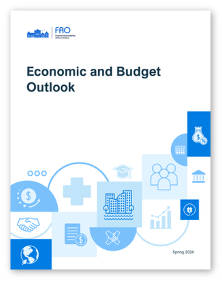
In addition to forecasts for the provincial economy, Economic and Budget Outlook (EBO) reports provide projections for the Province’s finances and compare the FAO’s provincial budget outlook to the government’s plans presented in Ontario Budgets and Ontario Economic Outlook and Fiscal Reviews (also known as Fall Economic Statements). In the Economic and Budget Outlook, Spring 2024 report, the FAO projected a $0.9 billion budget deficit in 2023-24, widening to a deficit of $6.4 billion in 2024-25. With revenue gains expected to outpace spending increases, the EBO projected a gradual improvement to a small budget surplus in 2028-29, under current government policies and announced commitments.
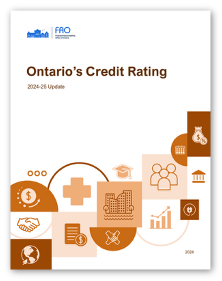
The FAO also provides an annual summary of the Province’s credit rating. The Province’s debt is rated by four principal international credit rating agencies, based on their assessments of Ontario’s economic and financial outlook, and future risks. These credit ratings represent the agencies’ opinions on the Province’s ability to meet its debt-related financial obligations. The FAO’s Ontario’s Credit Rating: 2024-25 Update noted that the credit rating agencies rate the Province as an extremely strong, investment-grade borrower, based on Ontario’s large and diversified economy, high liquidity and prudent debt management program. In 2024, one of the credit rating agencies upgraded Ontario’s credit rating, citing continued fiscal discipline and key financial risk metrics as key factors supporting the upgrade. The other three agencies reaffirmed their ratings.
Every two years, the FAO compares Ontario’s finances against the finances of the other provinces by reviewing per capita revenues, spending, budget balance and net debt. The 2022-23 Interprovincial Budget Comparison showed that while Ontario had the lowest revenues and program spending per capita, it had the highest net debt among the provinces, reflecting frequent budget deficits that have typically been higher than the rest of Canada.
To support Standing Committees’ reviews of ministries’ Expenditure Estimates, the FAO created a new interactive website titled Examining Ontario’s 2024-25 Expenditure Estimates. This website allows users to review a ministry’s Expenditure Estimates to the standard account level of detail, and compare requested spending against actual spending over the previous three years. For 2024-25, the FAO prepared information for 10 ministries, which accounted for 86 per cent of the Province’s 2024-25 spending plan in the 2024 Ontario Budget.
As part of the FAO’s spending plan review series, the FAO released Ministry of Children, Community and Social Services: Spending Plan Review. This report analyzed the ministry’s spending plan as set out in the 2024 Ontario Budget and the 2024-25 Expenditure Estimates, discussed the FAO’s spending projection by vote-item from 2023-24 to 2028-29, and identified key assumptions, issues and uncertainties.
On a quarterly basis, the FAO provides information on unaudited government spending. These Expenditure Monitor reports identify changes made by the Province to its spending plan, compare unaudited spending against the government’s spending plan and spending in the previous year, and report on the status of the Contingency Fund.
Financial Analysis of Government Programs and Policies
At the request of MPPs, committees, or on the initiative of the Officer, the FAO provides financial analysis of government programs or proposals. The FAO released the following four reports in 2024-25:
Ontario’s Public Transit Agencies: Ridership, Finances and Operating Subsidies examined Ontario’s municipal and provincial transit agencies’ ridership and finances, including own-source revenues, operating expenses and operating subsidies.
Ontario School Boards: School Building Condition, Student Capacity and Capital Budgeting reviewed school buildings in Ontario, including building condition and the state of good repair, compared student enrolment and school capacity to examine the number of schools that are under and over capacity, and provided an estimate of the cost to maintain school buildings in a state of good repair and to address capacity pressures over the next 10 years.
ServiceOntario Relocations: Financial Analysis of the Agreement with Staples Canada examined the Province’s plan to relocate nine ServiceOntario centres into Staples Canada stores. The report provided an overview of the agreement between the Province and Staples Canada, outlined the costs associated with this agreement, and compared these costs against the alternative of retaining the original operators under two scenarios.
The Financial Impact of Expanding the Beverage Alcohol Marketplace in Ontario estimated the financial impact to the Province of the decision to expand the beverage alcohol marketplace in Ontario, including the cost to accelerate that expansion to begin in 2024.
FAO Support for MPPs and Committees
The FAO provides independent financial and economic analysis to the members and committees of the Legislative Assembly of Ontario.
 46%
of Sitting Days FAO Mentioned in the House
46%
of Sitting Days FAO Mentioned in the House
The FAO primarily supports MPPs and committees through reports, briefing decks, videos, interactive graphics and tools, and learning modules. In addition, the FAO accepts research requests from MPPs and committees, offers briefings, produces a quarterly newsletter, and posts all work to the FAO’s website and social media channels.
One measure of the effectiveness of the FAO’s support for MPPs is through the use of our work in the House. In 2024-25, the FAO was referenced by MPPs in the House on 46 per cent of sitting days, down from 63 per cent in 2023-24.
% of Sitting Days FAO Mentioned in the House

Accessible version
| 2015-16 | 2016-17 | 2017-18 | 2018-19 | 2019-20 | 2020-21 | 2021-22 | 2022-23 | 2023-24 | 2024-25 |
|---|---|---|---|---|---|---|---|---|---|
| 60% | 62% | 67% | 53% | 65% | 61% | 56% | 64% | 63% | 46% |
 5
Standing Committees Referenced FAO Work
5
Standing Committees Referenced FAO Work
Of the Legislative Assembly’s eight Standing Committees, five referenced the FAO’s work in 2024-25, led by the Standing Committee on Social Policy and the Standing Committee on Finance and Economic Affairs, followed by the Standing Committee on Justice Policy; the Standing Committee on Heritage, Infrastructure and Cultural Policy; and the Standing Committee on the Interior.
Research Requests
 7
MPP Research Requests
7
MPP Research Requests
As mandated by the Financial Accountability Officer Act, 2013, the FAO accepts research requests from MPPs and committees under the following categories:
- the Province’s finances and trends in the provincial and national economies;
- the estimates and supplementary estimates submitted to the Legislature;
- the financial costs or financial benefits to the Province of any public bill that is before the Assembly; or
- to estimate the financial costs or financial benefits to the Province of any proposal that relates to a matter over which the Legislature has jurisdiction, including any proposal made by the Government or by any member of the Assembly.
The Financial Accountability Officer has the discretion to accept or reject a research request. The FAO considers whether the research request aligns within the Officer’s legislated mandate, whether the research request is expected to be feasible, and resource requirements.
In 2024-25, the FAO received seven research requests from MPPs and accepted five.
Briefings
 25
Briefings for MPPs and Staff
25
Briefings for MPPs and Staff
All work produced by the FAO is accompanied by briefings for interested MPPs, committees and staff. Each briefing includes an overview presentation and an opportunity for attendees to ask questions. To accommodate schedules, the FAO offers two briefings for interested MPPs and staff on the day a report is released. On request, the FAO will also schedule additional briefings for MPPs, committees or staff. In 2024-25, the FAO held 25 briefings for MPPs and staff, up from 13 in 2023-24.
Newsletters
The FAO releases a quarterly newsletter as a resource for MPPs and subscribers to stay informed on FAO activities. Each newsletter summarizes the FAO’s work over the previous quarter and lists upcoming FAO reports and other work, including research requests by MPPs.
Website
 199,313
Website Views
199,313
Website Views
All of the FAO’s work is publicly available on our website. In 2024-25, the FAO’s website accumulated 199,313 views, a record for the FAO and an 18 per cent increase from 2023-24.
The FAO refreshed its website in 2024-25, to improve access to its work for MPPs and the public. The new website features an updated design and improved functionality for a more intuitive user experience. Its upgraded search function and centralized archive allows easier and quicker access to the FAO’s reports by year, topic or series.
Website Views

Accessible version
| 2015-16 | 2016-17 | 2017-18 | 2018-19 | 2019-20 | 2020-21 | 2021-22 | 2022-23 | 2023-24 | 2024-25 |
|---|---|---|---|---|---|---|---|---|---|
| 34,897 | 91,473 | 74,857 | 108,202 | 179,760 | 169,717 | 197,278 | 184,010 | 169,490 | 199,313 |
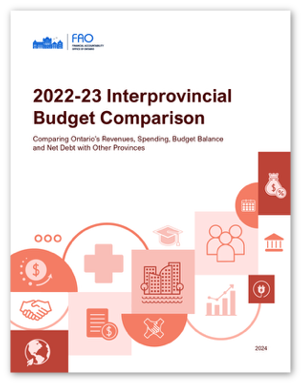
The FAO’s most popular report released in 2024-25, as measured by website views, was the 2022-23 Interprovincial Budget Comparison, with 6,321 views. The next most viewed reports released in 2024-25 were:
- Ministry of Children, Community and Social Services: Spending Plan Review
- The Financial Impact of Expanding the Beverage Alcohol Marketplace in Ontario
- Ontario’s Public Transit Agencies: Ridership, Finances and Operating Subsidies
- Ontario School Boards: School Building Condition, Student Capacity and Capital Budgeting
Social Media and Email Subscribers
FAO social media platforms are a key resource for MPPs and the public to stay up to date with FAO activities and reports. The FAO’s work is shared across three social media platforms: X (formerly Twitter), LinkedIn and Instagram. FAO content posted on these platforms allows MPPs and staff to access the FAO’s work in a timely, simple and quick medium.
Additionally, MPPs, staff, media and members of the public are able to subscribe to FAO News Alerts to receive email notifications on reports and newsletters.
The follower rate has steadily increased across all FAO social media platforms. When looking at year-over-year growth, in 2024-25, X followers increased by 7 per cent, LinkedIn followers increased by 8 per cent and Instagram followers increased by 4 per cent. Email subscribers increased by 11 per cent in 2024-25.
Access to and Disclosure of Information
Access to Information
Access to government information is a key requirement for the FAO to meet its legislated mandate. Under the Financial Accountability Officer Act, 2013, ministries and public entities have a statutory duty to provide the FAO with any information that the Officer believes necessary to perform his duties, with the exception of Cabinet records (see below) and personal information.
In addition, through four orders in council starting in 2016, Executive Councils have authorized ministries and public entities to provide the FAO with access to certain information contained in Cabinet records.
Disclosure of Information
Although the FAO has access to a wide range of information, the Financial Accountability Officer Act, 2013 and the orders in council place important restrictions on the FAO’s ability to publicly disclose certain types of non-public information that it receives from ministries and public entities.
Accordingly, the FAO has put in place internal processes that ensure information subject to these restrictions is not publicly disclosed. As part of these processes, ministries and public entities provide advice to the FAO, which helps to ensure that the FAO complies with its disclosure of information obligations.
In 2024-25, the FAO maintained its professional working relationship with ministries and public entities. The FAO made 19 information requests to the Province (23 in 2023-24) and was provided with timely access to all requested information as legally required.
Financial Statement
The Financial Accountability Office of Ontario’s fiscal year runs from April 1 to March 31.
Total spending (unaudited) by the FAO in 2024-25 was $4,261,917. This was $384,483 less than the FAO’s approved budget for 2024-25 and $267,506 more than total spending (audited) in 2023-24.
The accounts and financial statements of the FAO are audited annually by the Office of the Auditor General of Ontario. This financial statement was unaudited at the time of publication.
| 2024-25 Budget | 2024-25 Actual (Unaudited) | 2023-24 Actual | |
|---|---|---|---|
| Salaries and wages | $3,094,300 | $3,053,927 | $2,632,168 |
| Employee benefits | $742,700 | $602,360 | $612,325 |
| Transportation and communication | $56,500 | $16,154 | $12,764 |
| Services | $642,900 | $481,515 | $702,381 |
| Supplies and equipment | $110,000 | $107,960 | $34,773 |
| Total | $4,646,400 | $4,261,917 | $3,994,411 |
2024-25 The Year in Review
 14 Reports
14 Reports 9 Videos
9 Videos 199,313 Website Views
199,313 Website Views 1 Interactive Tool
1 Interactive Tool 14 Briefing Decks
14 Briefing DecksTop 5 Report Views
| 2022-23 Interprovincial Budget Comparison | 6,321 |
|---|---|
| Ministry of Children, Community and Social Services: Spending Plan Review | 5,264 |
| The Financial Impact of Expanding the Beverage Alcohol Marketplace in Ontario | 3,420 |
| Ontario’s Public Transit Agencies: Ridership, Finances and Operating Subsidies | 3,266 |
| Ontario School Boards: School Building Condition, Student Capacity and Capital Budgeting | 3,039 |
Supporting MPPs & Committees
 7 MPP Research Requests
7 MPP Research Requests 46% of Sitting Days FAO Mentioned in the House
46% of Sitting Days FAO Mentioned in the House 5 Standing Committees Referenced FAO Work
5 Standing Committees Referenced FAO Work 25 Briefings for MPPs and Staff
25 Briefings for MPPs and Staff

